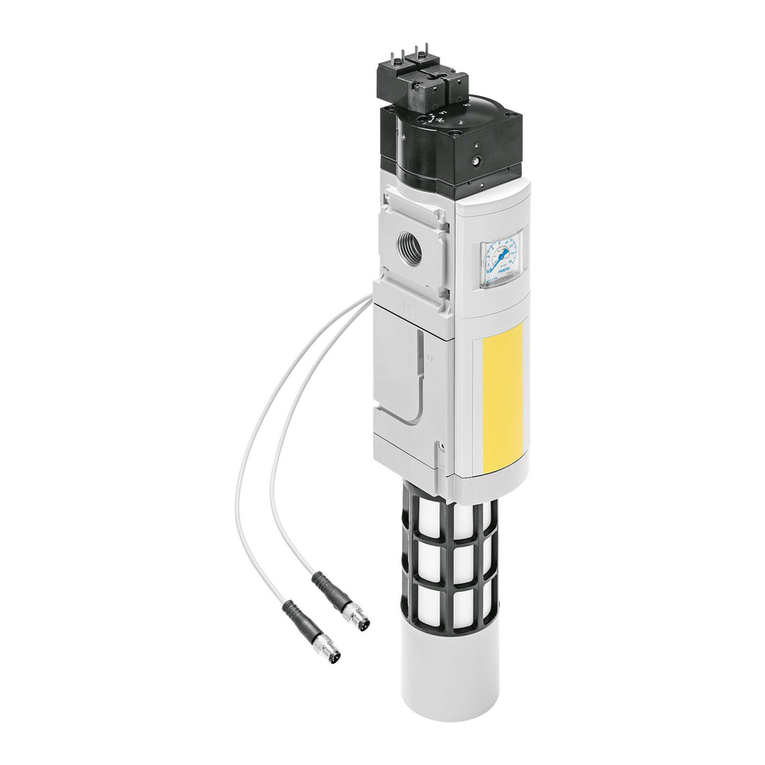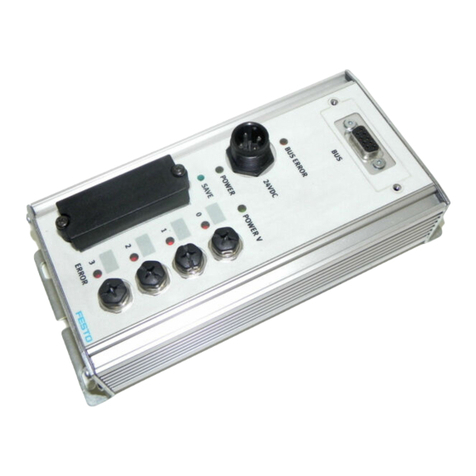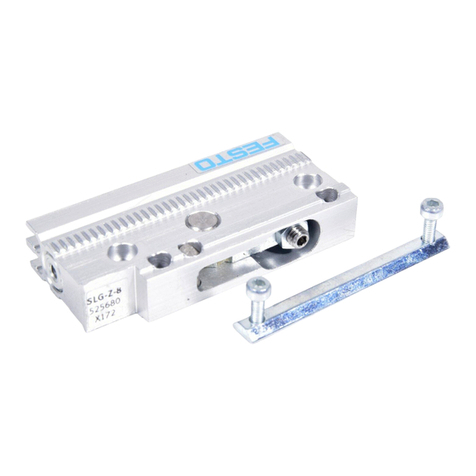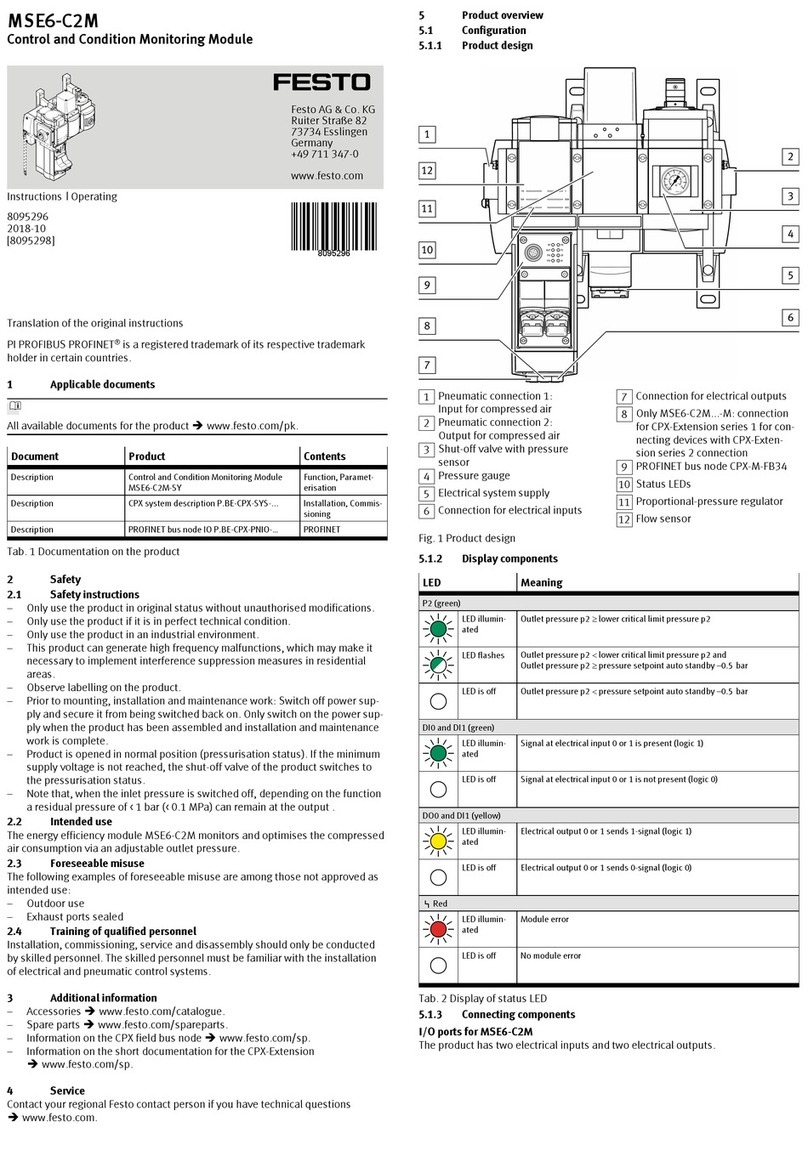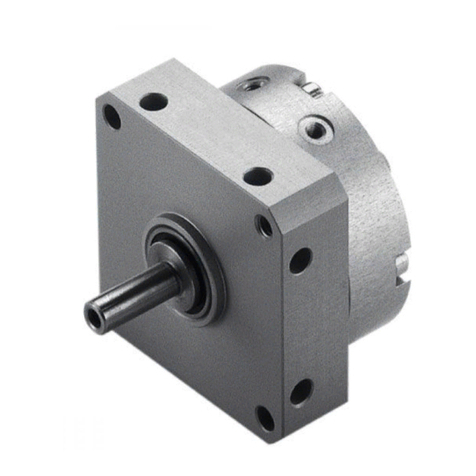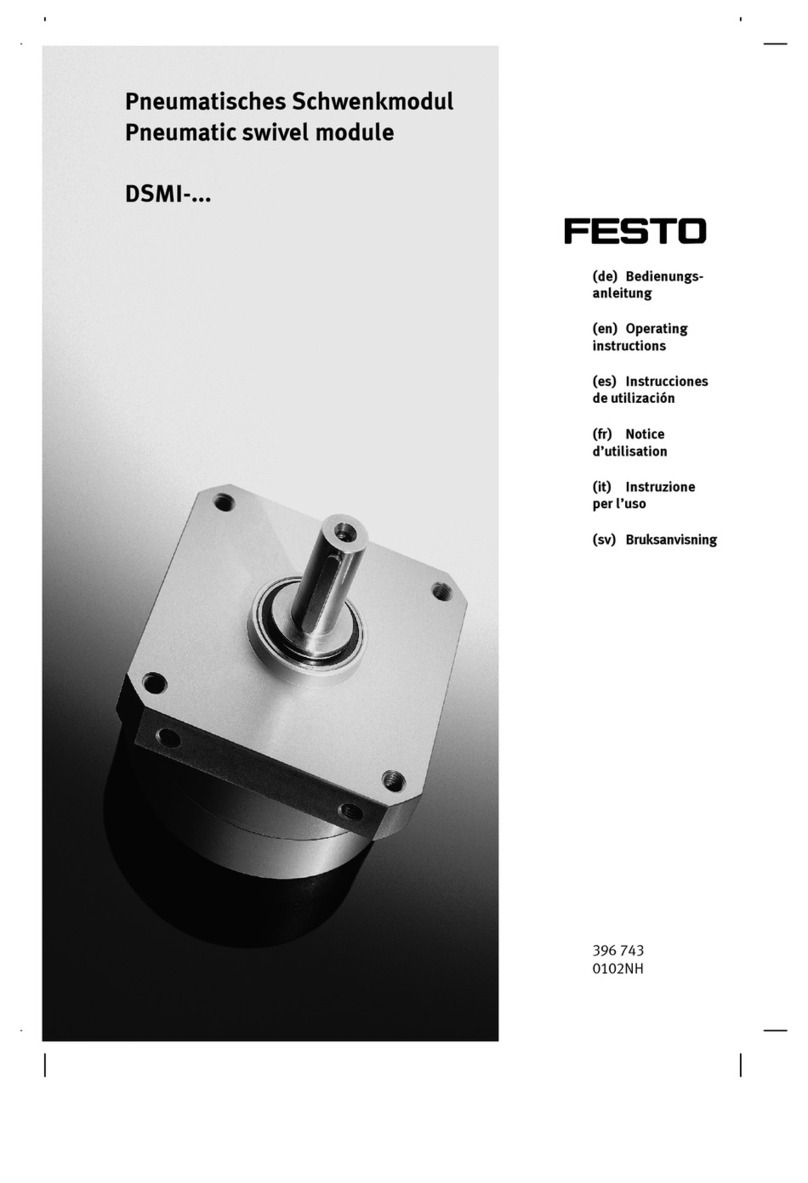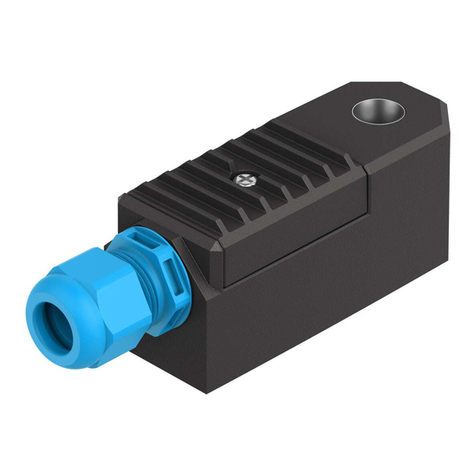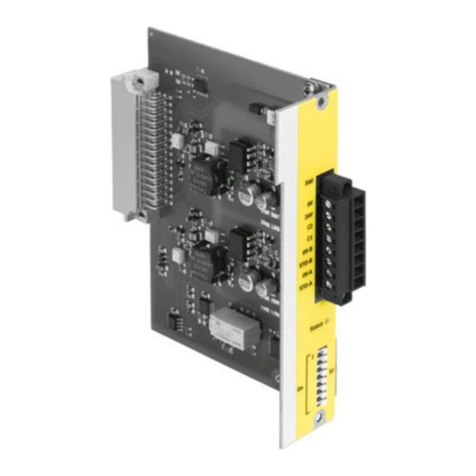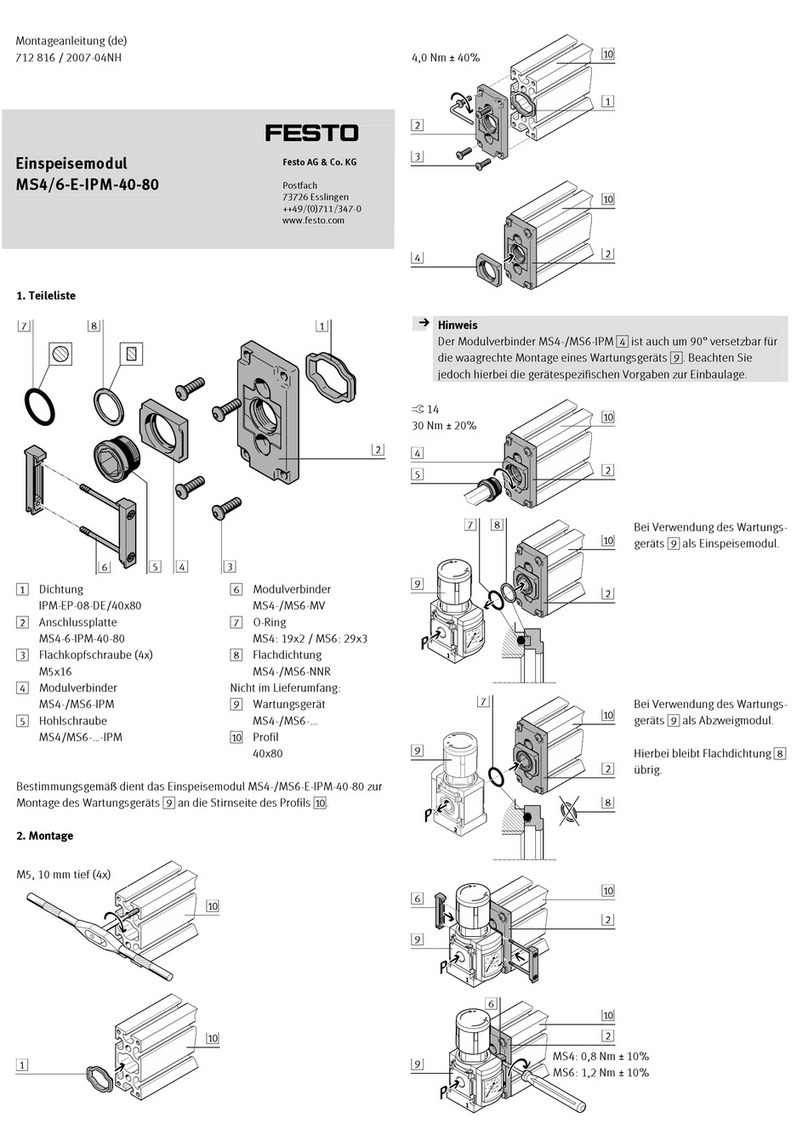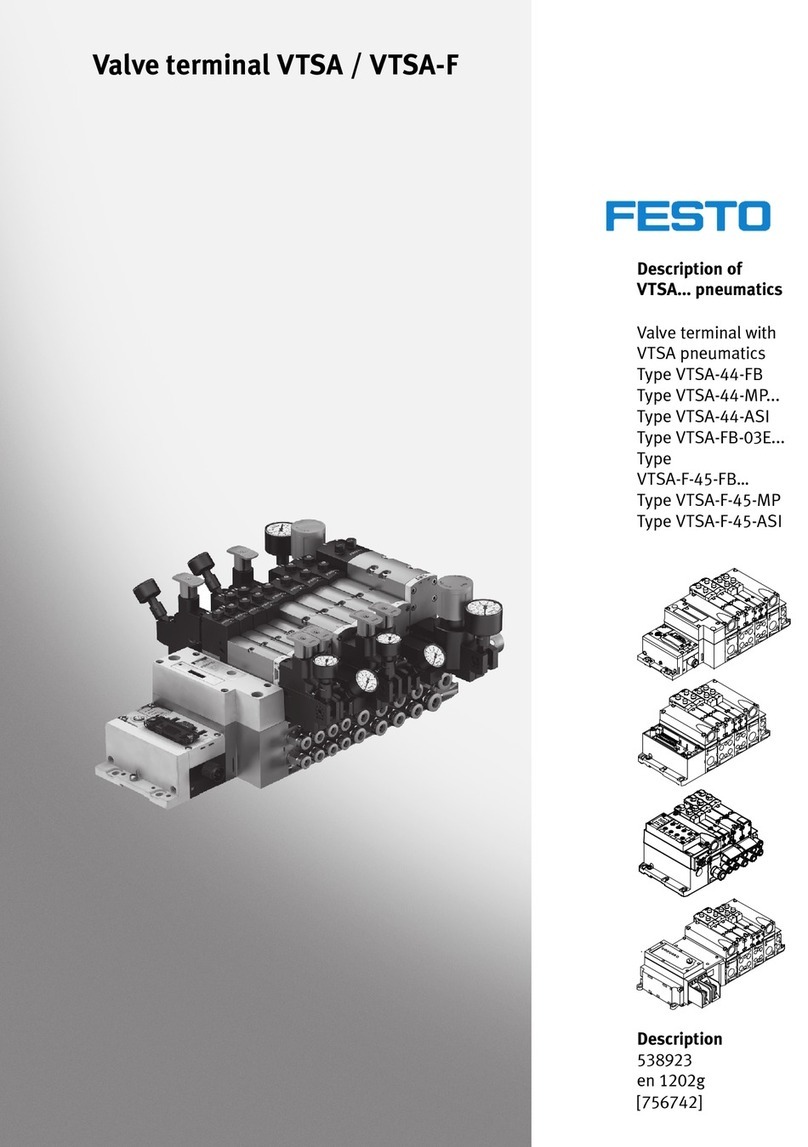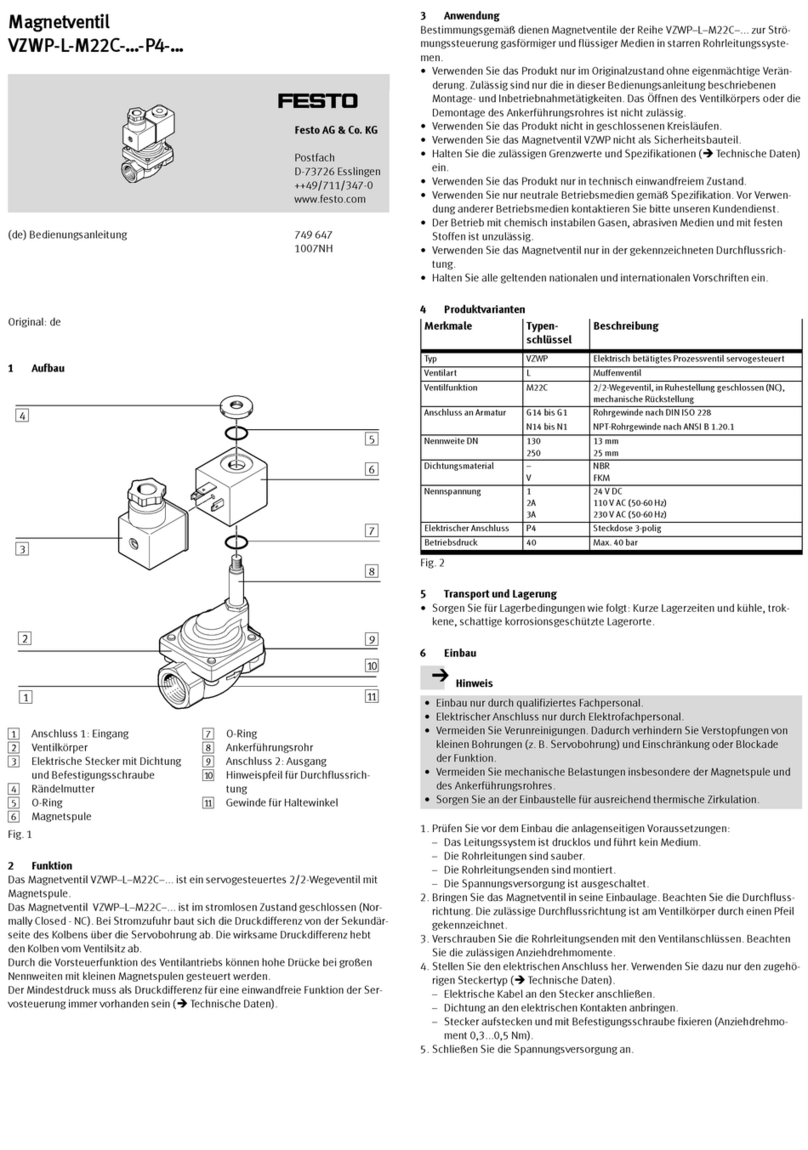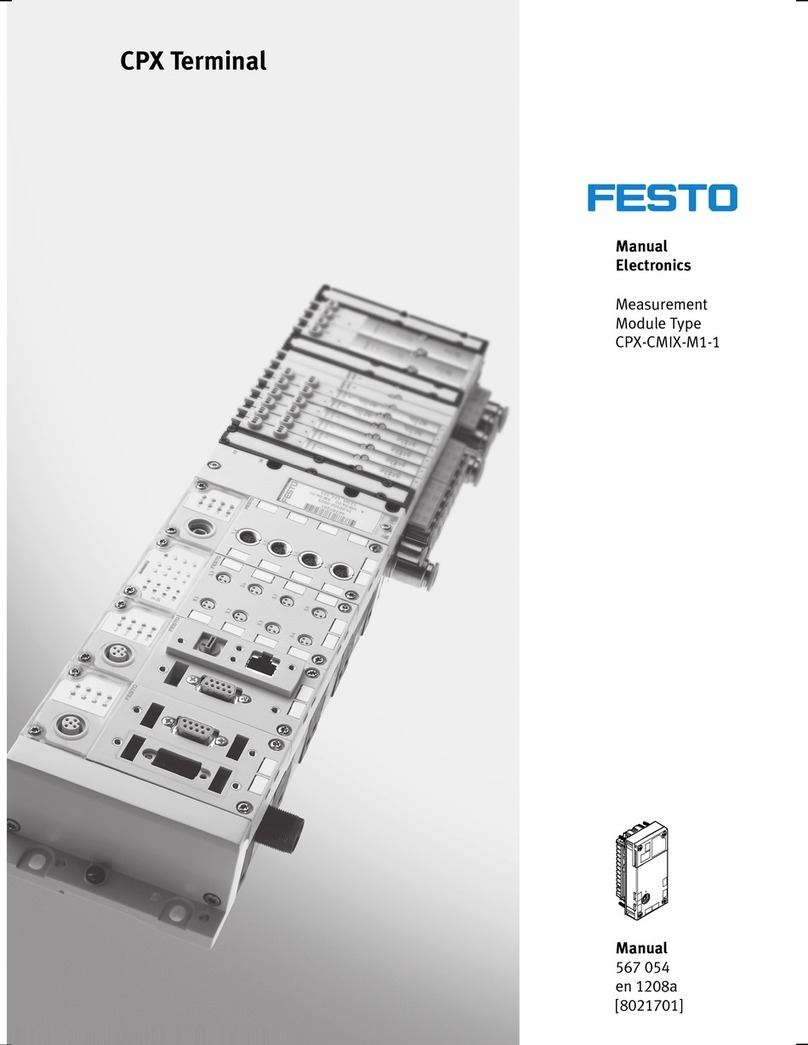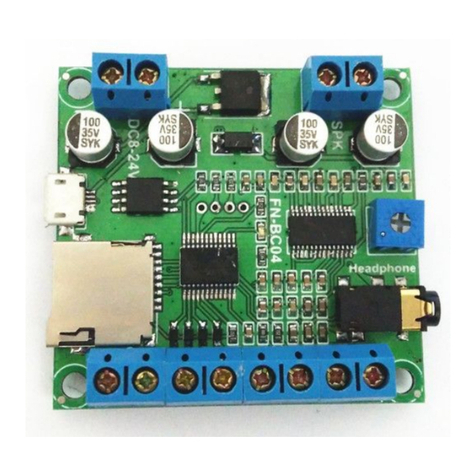– Operation of the CPXFVDAP2 within valve terminals is only permissible with
the following valve types:
Valve terminal Type Valve types
MPASFBVI 32 MPA1, MPA2 on VMPA…FBEMG…1)
MPAFFBVI 33 MPAF1, MPAF2 on VMPA…FBEMG…1)
VTSAFBVI 44 All up to width of 52mm1)
VTSAFFBVI 45 All up to width of 52mm1)
VTSAFCBVI 46 All1)
1) Malfunctions may occur if the resultant current is exceeded.
Tab. 2 Permissible valve types
– Operation of shutoff groups within valve terminals is only allowed in conjunc
tion with permissible pneumatics èDescription of the respective valveter
minal.
– Operation of shutoff groups in CPX terminals in the RemoteI/O operating
mode is only allowed with the following approved output modules:
Output module
CPX4DA1)
CPX8DA1)
CPX8DAH1)
CPX8DE8DA1)
1) Malfunctions may occur if the resultant current is exceeded.
Tab. 3 Permissible output modules
– Only the following components are permitted when assembling the CPX
FVDAP2:
Version Component Type
Interlinking block CPXMGEEVFVO
CPXMAB4M12X25POL
1 CPXFVDAP2 in combination
with certain manifold and
interlinking blocks of the
CPX terminal
Manifold block
CPXAB8KL4POL
2 Pneumatic interface VABAS61X...F1CB
3
CPXFVDAP21) as part of the
pneumatic interface of the
valve terminal VTSA‑F‑CB Pneumatic interface VABAS61X...F2CB
1) RevisionR04 (or a higher revision) of the output module required èRating plate of the electronics mod
ule CPX‑FVDA‑P2
Tab. 4 Permissible components
Further information about the supported product versions can be found in the
description CPXFVDAP2... and the description of the valve terminal VTSAFCB.
Detailed information about the product, the supported product versions and
required software versions as well as the permissible components of the CPX ter
minal can be found in the system description CPXSYS… èwww.festo.com/pk.
Information about permissible configurations of the CPX terminal in combination
with the output module can be found in the catalogue
èwww.festo.com/catalogue.
1.4 Foreseeable misuse
The following examples of foreseeable misuse are among those not approved as
intended use:
– Use outdoors
– Use in nonindustrial areas
– Use outside the limits of the product defined in the technical data
– Unauthorised modifications
– Use in combination with consumers where switching off can result in hazard
ous movements or conditions
NOTICE!
The use of manifold blocks, interlinking blocks and pneumatic interfaces that are
not specified is not permissible.
NOTICE!
In the following cases, the use of the output module CPXFVDAP2 for formation of
safety circuits is not permissible:
• In a CPX terminal equipped with CPXFEC or CPXCEC
• In a CPX terminal with shutoff groups containing output modules other than
those permitted
• In a CPX terminal of variant P
• In a CPX terminal with a connected valve terminal which is equipped with
valve types other than the following: VTSA, MPAS, MPAF
è Tab. 2 Permissible valve types
• In a CPX terminal with a connected valve terminal where a proportionalpres
sure regulator VPPM is located in switching groups with a safety shutdown
function
• In impermissible switching configurations èDescription CPXFVDAP2...
NOTICE!
The output module does not contain any wearing parts. Repairs are not allowed
on the output module CPXFVDAP2. This invalidates the certification of the out
put module. Professional replacement of the electronics module by the user is
permissible.
NOTICE!
In the event of damage caused by unauthorised manipulation or any form other
than the intended use, the warranty is invalidated, and the manufacturer is not
liable for damages.
1.5 Attainable safety level
With the CPXFVDAP2, safety functions can be implemented up to:
– Safety integrity level SIL3 in accordance with IEC61508
– Performance Level e, Cat. 3 in accordance with ENISO138491
– SIL claim limit SILCL3 in accordance with EN62061.
The attainable safety level of the overall safety device depends on the other com
ponents used to implement the safety function.
To maintain the safety level:
– Test the functionality of the safety device at adequate intervals.
1.6 Failures due to a common cause (Common Cause Failure – CCF)
Common cause failures cause the loss of the safety function, since both channels
(P and M) in a dualchannel system fail simultaneously.
The following measures ensure that common cause failures are avoided:
– Comply with operating voltage limits
– Comply with temperature range
è Tab. 16 Further characteristic values
è Fig.7
– Use a maximum of 2output channels in a common safety pilot circuit
Additional measures for avoidance of common cause failures may result from the
application.
1.7 Requirements for product use
– Make this brief description available to the design engineer, installation tech
nician and personnel responsible for commissioning the machine or system in
which this product is used.
– Keep this brief description throughout the entire product lifecycle.
– Make sure that the specifications of the documentation are always complied
with. Also comply with the documentation for the other components and
modules (e.g. bus nodes, pneumatics, etc.).
– Take into consideration the legal regulations applicable for the location as
well as:
– Regulations and standards
– Regulations of the testing organisations and insurers
– National specifications
– Remove all packaging, such as foils, caps, cardboard. The material used in
the packaging has been specifically chosen for its recyclability (exception:
oiled paper = residual waste).
– Assembly must be performed in a professionally correct manner. To maintain
the IP degree of protection:
– Screw the manifold block on tight
è 4.3 Assembling the electronics module.
– Mount cable entry and seals in a professionally correct manner.
– Seal unused ports with cover caps.
– If the system had to be shut down for safety reasons such as an emergency
stop, make sure the safety controller monitors/controls all system restarts.
1.8 Technical prerequisites
General conditions for the correct and safe use of the product, which must be
observed at all times:
– Comply with the technical operating limits è 7 Technical data.
Only then is operation of the product ensured in accordance with the relevant
safety regulations.
– When connecting standard auxiliary components, also observe the specified
critical limits for temperatures, electrical data and torques.
1.9 Training of skilled personnel
The device may only be commissioned by trained, qualified control and automa
tion technology personnel, who are familiar with:
– Installation and operation of control systems
– Applicable regulations for operating safetyrelated systems
– Applicable regulations for accident prevention and occupational safety
– The documentation for the product
NOTICE!
Work on safetyrelated systems may only be carried out by qualified personnel
trained in safety engineering.
1.10 Transport and storage conditions
– Protect the product during transport and storage from excessive stress
factors, such as:
– Mechanical loads
– Impermissible temperatures
– Moisture
– Aggressive atmospheres
– Store and transport the product in its original packaging.
The original packaging offers sufficient protection from typical stresses.
